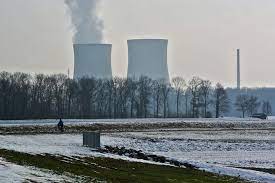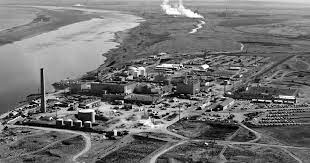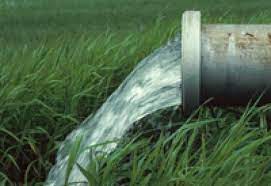Control and Prevention of Radioactive Pollution
Areas in various parts of the world have become contaminated with radionuclides as a result of various human activities. In cases where the level of contamination is high, measures might be needed to ensure that the area is safe for people to live or use for other purposes.
For small areas, it might be possible to do this by removing contaminated soil and other materials, but for large areas the amount of material would be too large.
Read Also : Complete List of Recyclable Wastes (Waste Recyclables)
Other ways of protecting people include restrictions on access to or use of areas, for example, preventing house building on areas affected by mining wastes that could produce high radon levels. Chemical treatments can also be used to reduce the amount of activity that gets from soil into food.
Examples of this include giving Prussian blue, a chemical that increases the rate at which caesium is excreted by the cow so that it does not get into milk and meat to cows grazing on contaminated grass in the Chernobyl area and treating the soil on Bikini Island with potassium to stop the trees absorbing caesium.
Radioactive Pollution Control/Preventive Measures
Some of the measures which can be used to control or prevent radioactive pollution are listed below:
Establishment of restricted areas
In the case of accidents where there has been significant local contamination, the local doses can be significantly greater than the dose constraint.
Where appropriate, measures are taken to minimize doses to people, such as the establishment of restricted areas in the vicinity of Chernobyl.
Following the nuclear accident at Chernobyl, over 100 000 people were moved from their homes in what are now Belarus, Ukraine and the Russian Federation, and various areas became restricted because of the levels of fallout on the ground.
A vast clean-up operation was mounted at the Chernobyl reactor site itself involving over 750 000 people. Such measures can reduce both the individual and collective doses substantially.
Proper radio active waste management
The aims of waste management are to process the wastes in such a way as to make them suitable for storage and disposal, and to store or dispose of them so that there are no unacceptable risks to present and future generations.
Here disposal implies simply that there is no intention to retrieve them, rather than that it would be impossible to do so.
In many countries, short lived waste is disposed of in near surface repositories, which are normally either lined trenches several metres deep or concrete vaults‘ constructed on or just below the ground surface. The disposed waste is covered with a few metres of earth, and often a clay cap to keep water out.
A similar disposal method is used in some countries for the disposal of large amounts of NORM (Naturally Occurring Radioactive Material) waste, such as tailings from the mining and milling of uranium.
For example, Sweden operates a repository under the bed of the Baltic Sea at Forsmark for its more active (but mostly short lived) low/intermediate level waste.
Many low/intermediate level wastes do not occur in a form that is immediately suitable for disposal; they have to be mixed into an inert material such as concrete, bitumen or resin. In the past, some countries disposed of these wastes into the ocean, but since that has been prohibited by the London Convention, these wastes are normally stored awaiting decisions on the method of disposal.
Among the most likely options is a repository deep underground in good geological conditions. Although many countries have plans for geological repositories of this type, only the USA is currently operating one, the Waste Isolation Pilot Plant (WIPP) in New Mexico, for wastes containing actinides.
Where the intention is to dispose of spent nuclear fuel directly rather than reprocess it, the spent fuel is stored, either at reactor sites or in special central facilities. This is partly to allow the fuel to cool, but clearly it must continue until a disposal facility is available.
High level liquid waste from reprocessing operations is normally kept in special cooled tanks, but facilities to solidify it by incorporation in vitreous material are being built. The glass blocks will be stored for several decades to allow them to cool before eventual disposal, probably deep underground.
Decommissioning
Decommissioning is the process that takes place at the end of the working life of a nuclear facility (or part of a facility), or any other place where radioactive materials were used, to bring about a safe long term solution.
This might include decontaminating equipment or buildings, dismantling facilities or structures, and removing or immobilizing remaining radioactive materials. In many cases, the ultimate objective is to clear the site of all significant radioactive residues, but this is not always possible or necessary.
Till date, relatively few full scale commercial nuclear facilities have been completely decommissioned. However a great deal of experience has been gained from the decommissioning of a wide variety of facilities, including a few nuclear power plants, several prototype and research reactors, and many laboratories, workshops, etc.
The fact that many nuclear reactors around the world are approaching the end of useful life has focused attention on the issues associated with decommissioning.

Decommissioning requires strict control of operations to optimize the protection of workers and the public. For dealing with the most radioactive parts of facilities, particularly reactor cores, remote handling techniques have been developed.
Dismantling of large facilities also generates large volumes of waste‘. Some of this will be low/intermediate level radioactive waste and needs to be managed accordingly. However, there may also be large amounts of structural materials such as steel and concrete that are not significantly radioactive. Special procedures may be needed to clear such materials as exempt, meaning that they do not have to be treated as radioactive waste.
Proper labeling
It is necessary for any material with radioactive content to be labeled, and the necessary precautions advised on the content of the label.
The reason for this is because radiation can enter the body by a mere touch of radioactive material. Containers with such elements should be well labeled in order to make one use protective gear when handling them.
Alternative energy sources
The evolution and use of nuclear power was not a bad thing initially. However, considering the damage and threats it has on the environment, it is high time for its use to be discontinued and for the world to perhaps focus on alternative and environmentally friendly energy sources like renewable sources of energy namely solar, hydro-electric and wind power.
The use of radioactivity to generate energy in nuclear power plants, for example, leads to the production of more radiation to the atmosphere considering the waste released from the various processes and combustion.
Proper storage
It is mandatory for containers carrying radioactive material to be stored properly. For starters, such substances should be stored in radiation proof containers to ensure no seeping or leakage during handling. Proper storage means no harm and can minimize cases of accidental leakage.
Efficient transport of radio active materials
Radioactive materials are routinely transported all around the world by air, sea, road and rail. These materials include those associated with the nuclear fuel cycle from uranium ores to spent fuel and radioactive waste but also radionuclides for nuclear medicine and research, and radioactive sources for industry and radiotherapy.
Although the safety record of these transports is excellent, they sometimes cause concern in the areas through which they pass. For example, a number of countries have expressed particular concern about ships carrying radioactive waste passing through or close to their territorial waters.
Regulations are, therefore, needed not just to ensure that the chances of an accident, which could result in radioactive material being dispersed in the environment, are kept to a minimum, but also to ensure that the workers involved in transport including those loading and unloading shipments as well as drivers/pilots are protected.
The IAEA (International Atomic Energy Agency) Regulations for the Safe Transport of Radioactive Material were first published in 1961 and have been revised periodically since.
The Regulations govern the necessary packaging, shielding, labelling and other precautions that must be taken when transporting various types of radioactive material, including tests that packages must undergo to prove that they can withstand possible accidents.
The requirements are graded according to the level of activity of the materials to be transported. In general, more hazardous radioactive materials need more extensive and more robust packaging and stricter quality and administrative controls.
The IAEA‘s Transport Regulations are widely accepted as the global standard for the transport of radioactive materials. In some cases, the Agency‘s Regulations are incorporated into national laws or regulations. Other countries write their own regulations governing transport of radioactive materials, but make them consistent with the IAEA Regulations.
Read Also : Hurts Wastewater Management Complete Guide
Another way in which the Agency‘s Regulations are applied is through international regulations on the transport of hazardous goods.
The regulations for the different modes of transport are issued by different organizations, particularly the International Civil Aviation Organization (ICAO) for air transport, the International Maritime Organization (IMO) for transport by sea, and regional organizations such as the Inland Transport Committee of the UN Economic Commission for Europe for transport by land and inland waterways.
These organizations regulations cover all types of hazardous material, and the parts that deal with radioactive materials are based on the IAEA Transport Regulations.
In summary, it is necessary for any material with radioactive content to be labeled, and the necessary precautions advised on the content of the label.
Decommissioning is the process that takes place at the end of the working life of a nuclear facility (or part of a facility).
It is mandatory for containers carrying radioactive material to be stored properly. Proper storage means no harm and can minimize cases of accidental leakage.
In areas contaminated with radioactive materials, measures might be needed to ensure that the area is safe for people to live or use for other purposes. In the case of accidents where there has been significant local contamination, the local doses can be significantly greater than the dose constraint.
Where appropriate, measures are taken to minimize doses to people, such as the establishment of restricted areas in the vicinity of Chernobyl.



